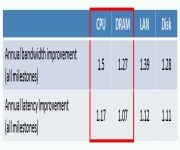Archive For The “Hardware” Category
In the last posting, Heterogeneous Computing using GPGPUs: NVidia GT200 I promised the next post would be a follow-on look at the AMD/ATI RV770. However, over the weekend, Niraj Tolia of HP Labs sent this my way as a follow-up on the set of articles on GPGPU Programming. Prior to reading this note, I hadn’t…
In Heterogeneous Computing using GPGPUs and FPGAs I looked at the Heterogeneous computing, the application of multiple instruction set architectures within a single application program under direct programmer control. Heterogeneous computing has been around for years but usage has been restricted to fairly small niches. I’m predicting that we’re going to see abrupt and steep…
It’s not at all uncommon to have several different instruction sets employed in a single computer. Decades ago IBM mainframes had I/O processing systems (channel processors). Most client systems have dedicated graphics processors. Many networking cards off-load the transport stack (TCP/IP off load). These are all examples of special purpose processors used to support general…
Whenever I see a huge performance number without the denominator, I shake my head. It’s easy to get a big performance number on almost any dimension but what is far more difficult is getting a great work done per dollar. Performance alone is not interesting. I’m super interested in flash SSDs and see great potential…
I did the final day keynote at the Conference on Innovative Data Systems Research earlier this month. The slide deck is based upon the CEMS paper: The Case for Low-Cost, Low-Power Servers but it also included a couple of techniques I’ve talked about before that I think are super useful: · Power Load Management: The…
Wow, 2TB for $250 from Western Digital: http://www.engadget.com/2009/01/26/western-digitals-2tb-caviar-green-hdd-on-sale-in-australia/. Once its shipping in North America, I’ll have to update The Cost of Bulk Cold Storage. Update: Released in the US at $299: Western Digital’s 2TB Caviar Green hard drive launches, gets previewed. Sent my way by Savas Parastatididis. –jrh James Hamilton, Amazon Web Services 1200, 12th…
In Microslice Servers and the Case for Low-Cost, Low-Power Servers, I observed that CPU bandwidth is outstripping memory bandwidth. Server designers can address this by: 1) designing better memory subsystems or 2) reducing the CPU per-server. Optimizing for work done per dollar and work done per joule argues strongly for the second approach for many…

In The Case For Low-Power Servers I reviewed the Cooperative, Expendable, Micro-slice Servers project. CEMS is a project I had been doing in my spare time in investigating using low-power, low costs servers running internet-scale workloads. The core premise of the CEMS project: 1) servers are out-of-balance, 2) client and embedded volumes, and 3) performance…
The Conference on Innovative Data Systems Research was held last week at Asilomar California. It’s a biennial systems conference. At the last CIDR, two years ago, I wrote up Architecture for Modular Data Centers where I argued that containerized data centers are an excellent way to increase the pace of innovation in data center power…
Earlier in the week, there was an EE Times posting, Server Makers get Googled, and a follow-up post from Gigaom How Google Is Influencing Server Design. I’ve long been an advocate of making industry leading server designs more available to smaller data center operators since, in aggregate, they are bigger power consumers and have more…
Related to The Cost of Bulk Storage posting, Mike Neil dropped me a note. He’s built an array based upon this Western Digital part: http://www.wdc.com/en/products/Products.asp?DriveID=336. Its unusually power efficient: Power Dissipation Read/Write 5.4 Watts Idle 2.8 Watts Standby 0.40 Watts Sleep 0.40 Watts And it’s currently only $105: http://www.newegg.com/Product/Product.aspx?Item=N82E16822136151. It’s always been the case that…

In the Cost of Power in Large-Scale Data Centers, we looked at where the money goes in a large scale data center. Here I’m taking similar assumptions and computing the Annual Cost of Power including all the infrastructure as well as the utility charge. I define the fully burdened cost of power to be the…
Intel Fellow and Director of Storage Architecture Knut Grimsrud presented at WinHEC 2008 last week and it caught my interest for several reasons: 1) he talked about Intel findings with their new SSD which looks like an extremely interesting price/performer, 2) they have found interesting power savings in their SSD experiments beyond the easy to…
In When SSDs Make Sense in Server Applications, we looked at where Solid State Drives (SSDs) were practical in servers and services. On the client side, there are even more reasons to use SSDs and I expect that within three years, more than half of enterprise laptops will have NAND Flash as at least part…

In past posts, I’ve talked a lot about Solid State Drives. I’ve mostly discussed about why they are going to be relevant on the server side and the shortest form of the argument is based on extremely hot online transaction processing systems (OLTP). There are potential applications as reliable boot disks in blade servers and…
This note describes a conversation I’ve had multiple times with data center owners and concludes that blade servers frequently don’t help and they sometimes hurt, easy data center power utilization improvements are available independent of the blade server premium, and enterprise data center owners have a tendency to buy gadgets from the big suppliers rather…